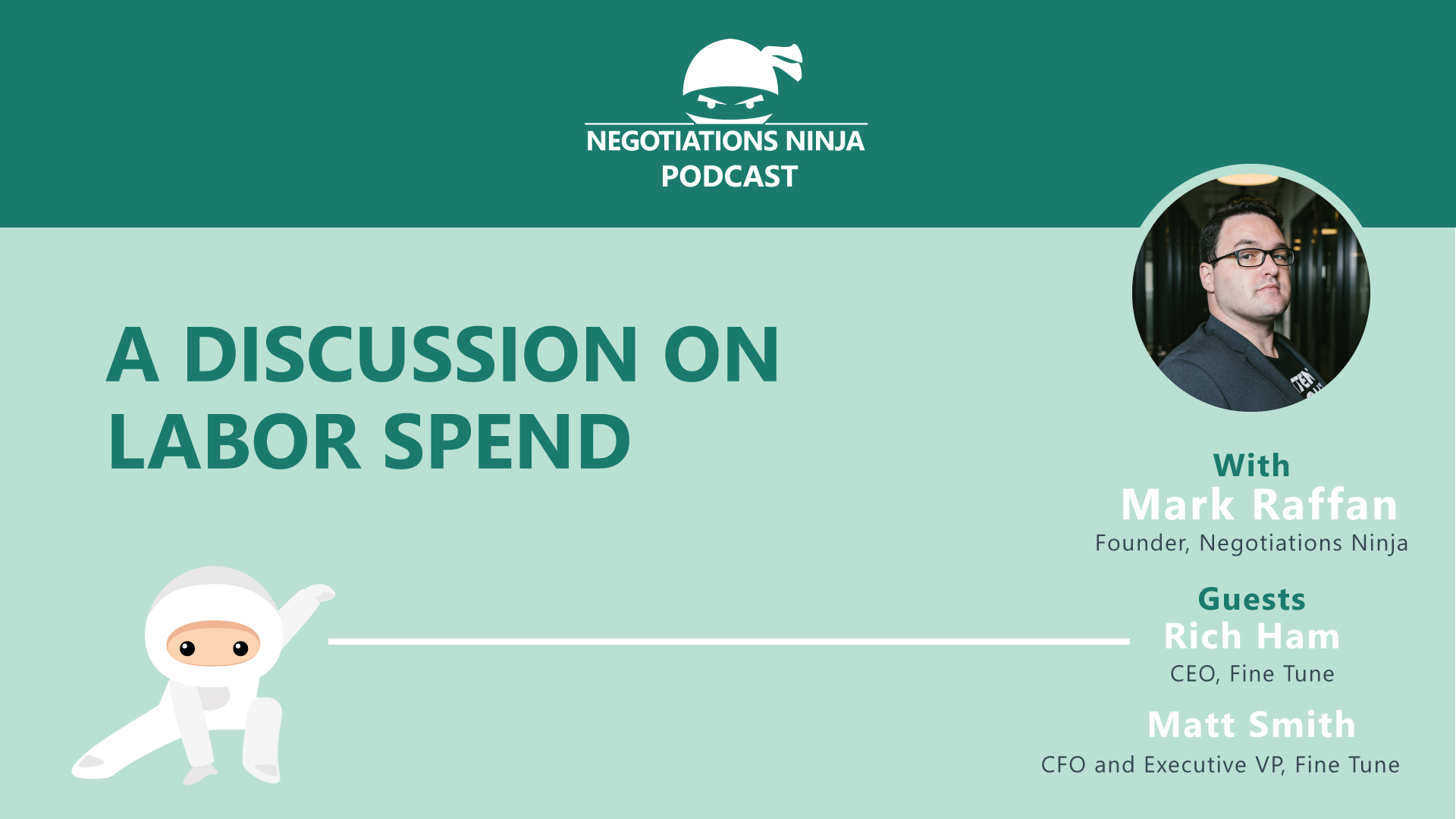There are a lot of vendors that capitalize on a company’s inability to properly manage labor categories. Rich Ham (the CEO) and Matt Smith (the CFO and Executive VP) of Fine Tune join me today to discuss the management of these labor categories. Where do they see some of the biggest gaps in a company’s abilities to do this? What can be done to remedy an otherwise tough situation? Listen to this procurement-focused episode of Negotiations Ninja to learn more!
Outline of This Episode
- [1:54] The nitty-gritty on Rich Ham + Matt Smith
- [4:47] The inability to properly manage labor categories
- [13:23] Managing a service versus an expense are two different disciplines
- [18:35] Separating the labor hour from the operation of the labor hour
- [20:32] What do you focus on in your negotiations?
- [23:18] How to operationalize and manage a labor-based contract
- [28:20] What can procurement teams do proactively
- [31:14] How to connect with Rich Ham + Matt Smith
Managing labor costs is a nuisance at best
Let’s say you’ve broken down labor hours and you understand the allocation of cost (vacation time, retirement benefits, unemployment insurance, overhead, etc.). You’ve done research to make sure dollars aren’t being hidden and you get a contract in place. Even if you’ve done it all, managing that contract at a site-based level is a significant nuisance.
From what Matt and Rich have seen, 25–40% of businesses mismanage labor categories. It’s compounded by the fact that they have disparate locations being managed by commission-based service people that are incentivized to grow the accounts and play the games. The client-side contacts that they interact with don’t have bottom-line cost incentive components in their plan.
Managing a service versus an expense are two different disciplines
Rich notes that managing a service and managing an expense are two different disciplines. The people that strategize and set up a company’s security program are often deficient when it comes to managing the costs. Their mission is security, so they will execute that mission. With someone in pest control, you’d interface with folks whose sole concern is to pass their quality audits—not keep costs low.
The people in quality and those working in security teams “carry a bigger stick” compared to procurement and other categories. This fear factor can prevent people from pursuing cost savings. But if you can bring the right combination of insider expertise on the service side and the commercial side, you really do find there are abundant savings available if you do things right. It doesn’t have to come with a compromise in terms of quality.
Matt interjects that the people in charge of the expense have bigger concerns than cost savings, like keeping their people and facilities safe. Or they can’t fail a safety or quality audit. But the people that are supposed to be thinking about cost savings claim that they’re just at the whims of the labor market. They expect a certain amount of “inflation” in those categories and often don’t address it. They say things like, “It will just go up every year.” It’s why you often see significant overpayment in these categories.
What do you focus on in your negotiations?
In an environment where procurement resources are lean, the issue to consider is what approach should be taken and what should be prioritized in the negotiation. Matt notes that the types of expenses we’re talking about present a buyer with a conundrum. The path to optimal costs is inconvenient, requires more time, and will be more difficult to manage on an ongoing basis. It’s why people leave money on the table because they’re prioritizing convenience. So they negotiate for a blended rate and leave money on the table because they aren’t taking a lasered approach.
To be fair, many suppliers don’t understand what is optimal. They ask for the best-blended rate and simply say “yes” to the best one. If you can bring on an industry insider that understands all of the components of the cost structure and can optimize each and every one, you still have to hold the supplier to that. In most of these industries, the suppliers aren’t set up to adhere to the agreement without continuous management. They can’t adhere to complex contracts with a lot of rules.
Matt has seen some really awesome contracts that are bad deals. Details can be spelled out but you end up in a situation that’s impossible to manage. The contract doesn’t line up with the invoices as early as one month in. The resemblance lessens even more over time.
What can procurement teams do to be proactive? Listen to the whole episode to learn more from Rich and Matt. If you feel that they’re speaking directly to your problem, reach out to them for help. Check out the resources below for more information!
Resources & People Mentioned
- Fine Tune: https://www.finetuneus.com/
- Fine Tune knowledge center: https://www.finetuneus.com/resources/
- Rich Young’s LinkedIn: https://www.linkedin.com/in/richkyoung/
Connect with Rich Ham
- Connect on LinkedIn: https://www.linkedin.com/in/richard-ham-51b38a10/
Connect with Matt Smith
- Connect on LinkedIn: https://www.linkedin.com/in/matthew-smith-4b986122/
Connect With Mark
- Follow Negotiations Ninja on Twitter: @NegotiationPod
- Connect with Mark on LinkedIn
- Follow Negotiations Ninja on LinkedIn
- Connect on Instagram: @NegotiationPod
- negotiations.ninja




